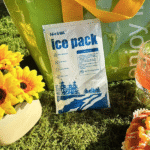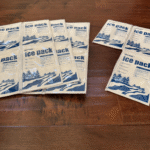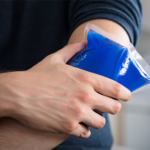Dry ice bags are essential tools in cold‑chain logistics, but are they food‑safe and BPA‑free? In this guide, you’ll learn what makes a dry ice bag food‑grade, how materials like LDPE influence safety, and why BPA matters. According to studies, low‑density polyethylene (LDPE) approved by the U.S. FDA is chemically stable and non‑toxic. However, not every bag on the market meets these standards. By the end, you’ll know how to choose a bag that protects your health, keeps shipments cold and complies with 2025 regulations.
-
Food‑grade standards for dry ice bags: what “food‑safe” means and how to verify it using certifications and material codes (long‑tail keyword: food‑grade dry ice bag).
-
BPA and plastic health concerns: why bisphenol A is used in some plastics, its health effects, and new regulations banning it (long‑tail keyword: BPA‑free dry ice bag).
-
Material comparison: how LDPE, HDPE, PP and other plastics differ in safety, BPA content and performance (long‑tail keyword: LDPE vs PP dry ice bag).
-
Practical tips: how to check labels, interpret recycling codes, use dry ice bags safely and reduce BPA exposure (long‑tail keyword: how to check if a dry ice bag is BPA‑free).
-
Emerging trends: 2025 updates on BPA regulations, sustainable materials and cold‑chain innovations (long‑tail keyword: 2025 dry ice packaging trends).
What Makes a Dry Ice Bag Food‑Safe?
Food‑safe dry ice bags are designed for direct contact with food or pharmaceuticals without contaminating them. They use high‑purity materials and must meet regulatory guidelines. Dry ice bags labeled food‑grade are manufactured with materials that do not leach harmful substances. Temk’s 2025 guide explains that food‑grade packs use high‑purity materials and adhere to U.S. FDA guidelines so they don’t release contaminants into food. Such standards are crucial for industries like meal delivery and vaccines.
Why Certifications Matter
-
FDA Compliance: In the United States, the Food and Drug Administration evaluates plastics for indirect food contact. When LDPE is used under approved conditions, it’s deemed safe for food packaging.
-
EU Regulations: Starting 20 January 2025, Commission Regulation (EU) 2024/3190 bans the use and trade of bisphenol A and other hazardous bisphenols in food‑contact materials. Manufacturers operating in the EU must transition to BPA‑free materials.
-
ISO and HACCP: Many food producers follow ISO 22000 and Hazard Analysis Critical Control Point (HACCP) standards. Look for mention of these on product documentation.
Food‑Grade Materials: LDPE, Metallocene and More
Several plastics are used in dry ice bags. Understanding each material helps you identify those that are safe and BPA‑free.
| Plastic Type | Food‑Safety & BPA Content | Common Uses | What it Means for You |
|---|---|---|---|
| LDPE (#4 – Low‑Density Polyethylene) | FDA confirms LDPE is safe for food contact. It is non‑toxic, odorless, chemically stable and does not contain BPA or phthalates. | Ice bags, squeeze bottles, plastic wrap. | Flexible and durable; ideal for dry ice bags because it resists cracking at low temperatures and won’t leach chemicals into food. |
| HDPE (#2 – High‑Density Polyethylene) | Safe and BPA‑free according to recycling guidelines. High chemical resistance. | Milk jugs, detergent bottles. | Suitable for rigid containers; some dry ice bags use multilayer HDPE for added strength. |
| PP (#5 – Polypropylene) | BPA‑free and heat‑resistant. | Medicine bottles, food containers. | Good for ice packs requiring higher heat resistance during sterilization. |
| PET (#1 – Polyethylene Terephthalate) | Free of BPA and widely recycled. | Beverage bottles, jars. | Less flexible than LDPE; rarely used for ice bags but relevant for some packaging. |
| PVC (#3 – Polyvinyl Chloride) | Often contains BPA or other plasticizers. | Pipes, some packaging. | Avoid for food contact; not suitable for dry ice bags. |
| Polycarbonate & Epoxy Resins (mixed #7) | Contain BPA; used in rigid water bottles and can liningsfda.gov. | Shatterproof products, can coatings. | Should be avoided for food‑contact packaging once EU bans take effect. |
Key Insight: Choose dry ice bags made from LDPE, HDPE or PP. These plastics are generally free of BPA and meet food‑contact safety standards. Avoid bags made from PVC, polycarbonate or unspecified “mixed plastics” marked with recycling code 3 or 7.
Practical Tips for Choosing Food‑Safe Bags
-
Look for Food‑Grade Labels: Packaging should explicitly mention food‑grade or FDA compliance. Avoid generic “industrial” ice bags for food shipments.
-
Check Recycling Codes: Codes 1 (PET), 2 (HDPE), 4 (LDPE) and 5 (PP) are generally considered BPA‑free. Codes 3 and 7 may contain BPA.
-
Verify Certifications: Request proof of compliance with FDA, EU regulation (2024/3190) or local food‑contact laws. If you ship globally, choose a bag that meets both U.S. and EU standards.
-
Ask About Materials: Contact the manufacturer to confirm the resin used. Legitimate suppliers will specify LDPE, metallocene or other polymers.
-
Inspect for Quality: Food‑safe bags should have uniform thickness, strong seams and no chemical smell. LDPE bags often have a slightly translucent, waxy appearance.
Case Study: A meal‑kit company in California switched from generic ice bags to FDA‑approved LDPE dry ice bags for seafood shipments. Customer complaints about fishy odors dropped, and the company noted longer shelf life and improved brand trust.
Reading Beyond the Label
Even with food‑grade labels, not all bags are equal. High‑quality dry ice bags are often made from metallocene‑modified LDPE, which combines low‑density polyethylene with metallocene catalysts. These catalysts produce a stronger polymer with high impact strength and clarity. A supplier of metallocene ice bags advertises high impact strength, low haze/high gloss and excellent durability. Such features indicate a bag designed for food use and repeated handling.
Why Is BPA a Concern in Packaging?
Bisphenol A (BPA) is an industrial chemical used since the 1960s to make polycarbonate plastics and epoxy resinsfda.gov. These materials are found in shatterproof bottles and epoxy linings of metal cans. When heated or aged, BPA can migrate into food, prompting concerns about health effects.
Health Effects of BPA and Regulatory Moves
-
Leaching into Food: BPA can leach into food from epoxy coatings in canned foods and from consumer products like polycarbonate tableware, water bottles and baby bottles. The leaching increases with temperature.
-
Widespread Exposure: The U.S. Centers for Disease Control and Prevention found detectable levels of BPA in 93 % of urine samples from people aged six and older. This demonstrates that exposure is widespread.
-
Endocrine Disruption: BPA is classified as an endocrine‑disrupting chemical. According to the National Institute of Environmental Health Sciences, endocrine disruptors mimic or interfere with the body’s hormones and are associated with various health issues.
-
Vulnerable Populations: Animal studies suggest infants and fetuses may be particularly sensitive to BPA’s effects, prompting guidance for parents to minimize exposureniehs.nih.gov.
-
Regulatory Responses: The EU has adopted a complete ban on BPA in food‑contact materials effective 20 January 2025. The U.S. FDA still considers BPA safe at current exposure levelsfda.gov but has banned its use in baby bottles, sippy cups and infant‑formula packaging. Expect more jurisdictions to tighten restrictions as new research emerges.
Tips to Reduce BPA Exposure
-
Avoid Heating Polycarbonate: Do not microwave or heat polycarbonate food containers; high temperatures accelerate BPA leaching.
-
Check Recycle Codes: Plastics with recycling codes 3 or 7 may contain BPA. Opt for codes 1, 2, 4 or 5.
-
Reduce Canned Foods: Choose fresh or frozen foods to reduce exposure from can linings.
-
Use BPA‑Free Alternatives: Select glass, stainless steel or porcelain containers for storing or heating food.
-
Select BPA‑Free Baby Products: Use baby bottles explicitly labeled BPA‑freeniehs.nih.gov.
Environmental Considerations
BPA’s replacement chemicals and plastic waste create environmental concerns. LDPE, while safer for food contact, is non‑biodegradable and contributes to plastic pollution. According to a 2024 review, LDPE waste often ends up in landfills because recycling programs for soft plastics are limited. Sustainable alternatives like bioplastics (PLA) and reusable gel packs are gaining popularity. When choosing packaging, consider both human health and environmental impact.
How to Verify a Dry Ice Bag Is BPA‑Free
Selecting a BPA‑free dry ice bag involves more than reading marketing claims. Follow a systematic approach to ensure the bag meets your safety requirements.
Reading Recycling Codes and Certifications
-
Locate the Resin Identification Code: Most plastic bags have a small triangle with a number. Codes 1 (PET), 2 (HDPE), 4 (LDPE) and 5 (PP) are generally BPA‑free. Avoid bags marked 3 (PVC) or 7 (other) because they can contain BPA.
-
Look for BPA‑Free Labels: Manufacturers often display “BPA‑free” or “food‑grade” prominently. While not mandatory, it indicates the company recognizes consumer safety concerns.
-
Check for Certification Marks: Certifications such as FDA CFR 21 compliance, EU Regulation 2024/3190 conformity, or NSF/ANSI Standard 2 show the product was tested for food contact safety.
-
Review Material Data Sheets (MDS): Responsible suppliers provide an MDS listing the resin type, additives and compliance status. Confirm that the polymer is LDPE, HDPE or PP without BPA.
-
Contact Manufacturers: If details are unclear, reach out to suppliers. Reputable companies will answer questions about materials and compliance.
Step‑by‑Step Verification Example
Suppose you receive a shipment of dry ice bags from a supplier:
-
Inspect the Code: You see recycling code 4—indicating LDPE. This is a good sign because LDPE is safe and BPA‑free.
-
Check the Label: The packaging reads “Food‑Grade LDPE – BPA‑Free.”
-
Ask for Certification: The supplier provides an FDA compliance statement and notes that the bags comply with EU Regulation 2024/3190.
-
Confirm Material: The material data sheet lists LDPE with metallocene catalysts and no BPA.
-
Make an Informed Decision: You can confidently use these dry ice bags for food shipments.
Benefits of Using BPA‑Free, Food‑Safe Dry Ice Bags
Choosing the right bag doesn’t just protect health—it yields several practical advantages.
-
Health Protection: Bags free of harmful chemicals prevent contamination of food and pharmaceuticals. LDPE and HDPE do not release BPA or phthalates.
-
Regulatory Compliance: Selecting BPA‑free bags ensures compliance with the EU’s 2025 bantrade.ec.europa.eu and reduces the risk of product recalls or fines.
-
Brand Reputation: Demonstrating a commitment to safety and sustainability increases consumer trust. Many eco‑conscious customers seek products packaged in BPA‑free materials.
-
Thermal Performance: High‑quality metallocene LDPE bags maintain structural integrity at sub‑zero temperatures and reduce leakage. This keeps dry ice contained and extends cold life.
-
Versatility: Food‑grade dry ice bags can also be used for ice packs, gel packs and other cold‑chain applications, offering operational efficiency.
-
Sustainability: With proper recycling and reuse programs, LDPE bags can be recycled, and newer bioplastic alternatives are emerging.
How to Use Dry Ice Bags Safely
Safe handling of dry ice bags protects workers and packages. Remember that dry ice is the solid form of carbon dioxide and sublimates directly to gas, which can build pressure. Hazmat University notes that packaging used to ship dry ice must allow venting of carbon dioxide gas to prevent pressure buildup. Here are best practices:
Safe Handling Guidelines
-
Ventilation: Do not seal dry ice in airtight containers. Use bags with vent holes or pair them with vented outer packaging. This prevents pressure that could cause a bag to burst.
-
Proper Labeling: When shipping, mark the outer carton with the Class 9 hazard label and UN number UN1845. Indicate the net weight of dry ice.
-
Protective Equipment: Wear insulated gloves and goggles when handling dry ice to avoid cold burns. Ensure that CO₂ vapors do not accumulate in confined spaces.
-
Weight Limits: Air carriers like IATA limit dry ice quantities per package (often 2.5 kg for passengers); confirm regulations before shipping.
-
Dispose of Properly: Let leftover dry ice sublimate in a well‑ventilated area away from pets and children. Do not dispose of dry ice in sinks or trash bins.
Practical Scenarios
-
Food Delivery Service: Place the BPA‑free dry ice bag inside an insulated cooler with ventilation holes. Use a secondary leak‑proof liner around the food to prevent direct contact with the bag. Clearly label the package for couriers.
-
Laboratory Shipments: When shipping biological samples, ensure the dry ice bag is compatible with the required temperature range. Follow IATA packing instructions (PI954) and include documentation about dry ice weight.
-
Outdoor Use: For camping trips, use smaller BPA‑free dry ice bags to maintain frozen foods. Keep the cooler lid slightly ajar to allow gas to escape.
Real‑World Example: A biotech company shipping vaccines uses 1 kg of dry ice in a vented LDPE bag within a UN‑rated insulated container. They label the package UN1845 and include the net weight of dry ice. The shipment arrives without pressure issues, and vaccine vials remain within safe temperature ranges.
2025 Trends in Dry Ice Bag Safety and Sustainability
Trend Overview
The cold‑chain industry is evolving rapidly. Several trends will shape dry ice bag design and usage in 2025:
-
Stricter BPA Regulations: The EU’s 2024/3190 regulation bans BPA in food‑contact materials from January 2025. Companies must switch to BPA‑free plastics or biobased alternatives.
-
Advanced Materials: Expect wider adoption of metallocene‑modified LDPE and coextruded films that enhance strength and puncture resistance while remaining BPA‑free. Some manufacturers are experimenting with ethylene‑vinyl acetate (EVA) blends for improved cold flexibility.
-
Sustainable Alternatives: Bioplastics derived from sugarcane (PLA) and reusable gel pack pouches are gaining traction. These materials reduce environmental impact and often comply with food‑contact regulations.
-
Smart Packaging: Sensors and QR codes embedded in dry ice bags monitor temperature and CO₂ levels, alerting shippers when venting is insufficient.
Latest Developments at a Glance
-
EU Ban Implementation: As of 20 January 2025, any plastic article containing BPA will be illegal for food contact in the EU. Companies are proactively reformulating materials.
-
Research on Alternative Bisphenols: Scientists warn that some BPA replacements (BPF, BPS) may have similar endocrine activity. Regulation is expected to expand to these analogs, prompting a shift to non‑bisphenolic materials.
-
Improved Recycling Programs: Municipalities are expanding soft‑plastic recycling to address LDPE waste. Consumers will have more opportunities to recycle ice bags, reducing environmental impact.
Market Insights: Demand for cold‑chain packaging continues to grow with online grocery and pharmaceutical shipping. Customers increasingly seek eco‑friendly, BPA‑free solutions. Companies offering transparent certifications and sustainable materials gain a competitive advantage.
Frequently Asked Questions
Q1: Are all dry ice bags food‑safe?
No. Only bags labeled food‑grade and made from materials approved for food contact (such as LDPE, HDPE or PP) can be considered food‑safe. Avoid generic or industrial ice bags without certification.
Q2: How can I tell if a dry ice bag is BPA‑free?
Check the recycling code on the bag. Codes 1, 2, 4 and 5 are typically BPA‑free. Look for “BPA‑free” labels and ask the manufacturer for material data sheets confirming the absence of BPA.
Q3: Why is BPA still used if it’s banned in the EU?
BPA imparts clarity and durability to polycarbonate plastics. The U.S. FDA currently considers BPA safe at current exposure levelsfda.gov, though it has banned BPA in baby productsfda.gov. Regulatory views differ globally, but momentum is shifting toward elimination.
Q4: Can dry ice be placed directly inside a food container?
No. Dry ice should never touch food directly because it can cause freezer burn and may alter taste. Always place dry ice in a separate BPA‑free, food‑grade bag and create a barrier between the dry ice and food.
Q5: Does LDPE release microplastics into food?
When used properly and within approved temperature ranges, LDPE is chemically stable and does not leach harmful substances into food. However, improper use (e.g., prolonged exposure to high heat) can degrade the polymer. For high‑heat applications, consider alternative materials like PP.
Summary & Recommendations
Key Takeaways: Dry ice bags used for food or pharmaceutical shipments should be food‑grade, BPA‑free and properly vented. The safest materials are LDPE, HDPE and PP; these plastics are non‑toxic and do not contain BPA. BPA can leach into food from certain plastics and is associated with health concerns such as endocrine disruptionniehs.nih.gov. The EU bans BPA in food‑contact materials from January 2025, signalling a global move toward safer packaging. Always check recycling codes, ask for certifications and avoid code 3 or 7 plastics.
Action Plan:
-
Audit Your Packaging: Identify the resin codes used in your current dry ice bags. Replace any bags made of PVC or polycarbonate with LDPE or PP versions.
-
Verify Compliance: Request documentation from suppliers proving FDA compliance and alignment with EU Regulation 2024/3190.
-
Educate Staff: Train employees on safe handling of dry ice, including venting requirements and labeling for hazardous goods.
-
Implement Recycling: Establish a program to recycle LDPE bags and explore bioplastic alternatives for non‑critical shipments.
-
Communicate Transparently: Highlight your use of BPA‑free, food‑grade packaging in marketing to reassure customers and meet growing consumer demand for safer materials.
About Tempk
Tempk is a leader in cold‑chain packaging solutions, providing food‑grade, BPA‑free dry ice bags and innovative gel packs engineered for pharmaceuticals, meal kits and life‑science shipments. We prioritize safety and sustainability, using materials like metallocene LDPE and recyclable bioplastics. Our products comply with U.S. FDA, EU Regulation 2024/3190 and ISO standards, giving customers peace of mind. We also offer customizable sizing and venting options to ensure compliance with IATA and IMDG packaging requirements.
Ready to upgrade your cold‑chain packaging? Contact our experts for a free consultation, or explore our Dry Ice Shipping Guide for more insights. You can also try our interactive Bag Size Calculator to determine the right dry ice bag for your shipment.























